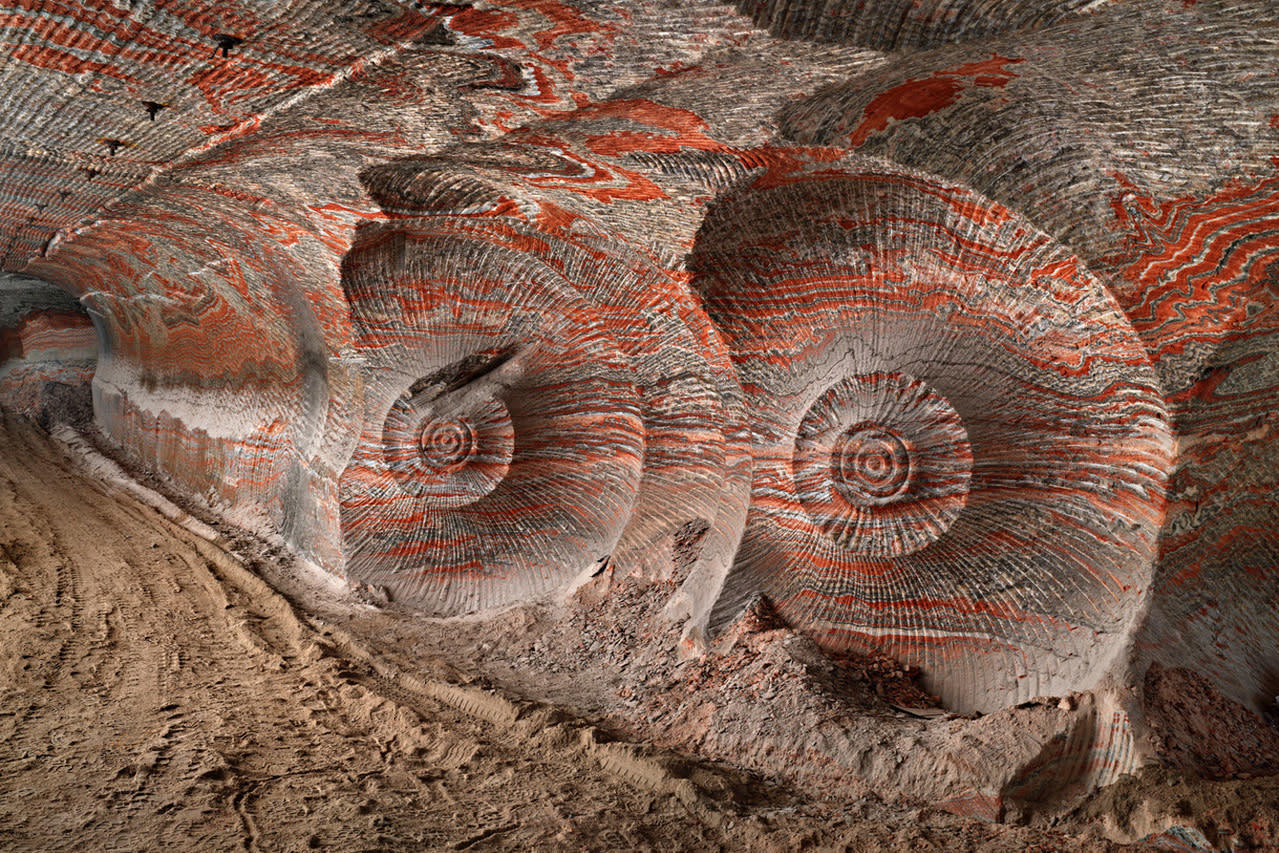October has been a busy month for Edward Burtynsky. Most significantly, the Canadian artist released a new series of his photographs, titled Anthropocene, on until November 3 at Toronto’s Nicholas Metivier Gallery. With collaborators Jennifer Baichwal and Nicholas de Pencier, he also launched the traveling museum exhibition Anthropocene at the Art Gallery of Ontario, and his latest feature length film Anthropocene: The Human Epoch, which is playing at TIFF theaters until October 11th.
Burtynsky is best known for his aerial photography which captures the societal and ecological effect of human systems on the earth, ideas he’s expanded on in previous documentaries Manufactured Landscapes (2006) and Watermark (2013).
We got in touch with Burtynsky to learn more about the Anthropocene Project, and how it revisits themes and locations explored in his earlier works.
Format Magazine: I was surprised to hear that you hadn’t used the word “Anthropocene” as a word for your work before, because it seems like the perfect term I wanted to ask you about how your work is responding to the subject.
Edward Burtynsky: Well, going back to the word Anthropocene, the word was minted by a gentleman Nobel Award winner Paul J. Crutzen. In the 2000s, he thought the impact humans were having on the planet was significant enough to put forward the idea that we have now entered into a new epoch. The agency for this epoch is humans. The evidence of that is found in all kinds of different places. The scientists engaged with it were looking for geological evidence. The things that we’re leaving [behind], will leave traces of who we are, and those traces will go deep into the future.
For instance aluminum, concrete, alloys, and plastics are not something nature can create. So, these things, as they get caught up in sediments and in different places that plastics might concentrate, future geologists two million years from now while chipping away at a layer [of sediment] will say, “Oh, this is when humans made plastic and spread it all over the planet.”
The scientists were trying to find, what’s the moment of the Anthropocene? What’s that signature around the planet? The time that’s most quoted and favored is all the nuclear testing that was done in the 50s, 60s, and 70s. All that radiation came down onto the planet, so there’s a signature. Whether you’re on the North Pole or the South Pole, the oceans, or Mount Everest, you’ll find radionuclide from the testing they did. It’s everywhere. They see that as the potential signature of the Anthropocene.
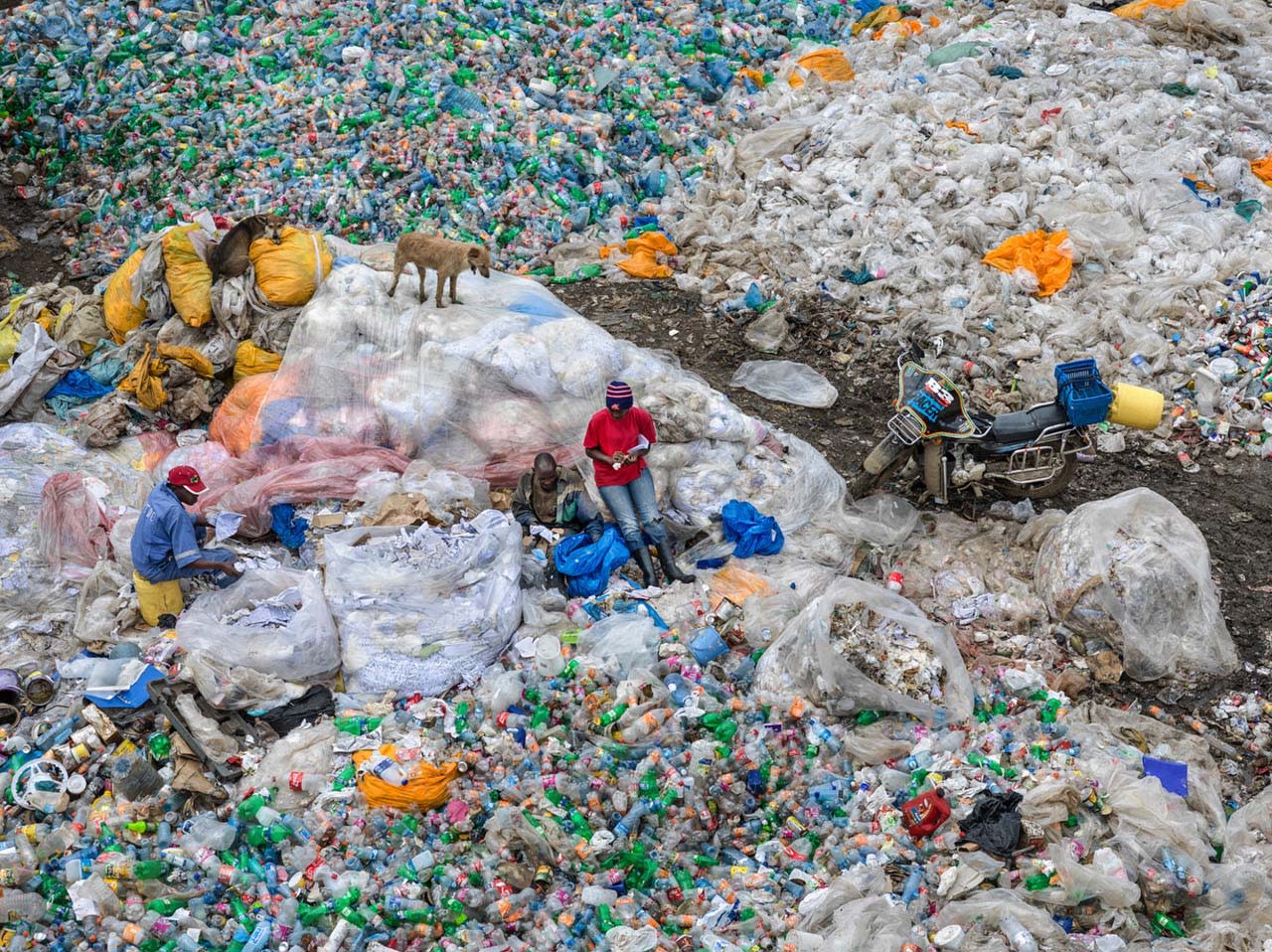
Edward Burtynsky, Dandora Landfill #3, Plastics Recycling, Nairobi, Kenya, 2016. Pigment inkjet print on Kodak Professional Photo Paper © Edward Burtynsky, courtesy Metivier Gallery, Toronto.
So it’s this time-stamping of the impact of human intervention. I’ve been reading Timothy Morton’s Dark Ecology, where he talks a bit about the Anthropocene.
Oh, I just picked that up and started to read it!
It’s good! One thing I’ve gleaned from him is thinking about the earth as an entity on its own—not just thinking about humans and the way that the earth exists for us, but how we’re impacting it and what it might be like after we’re gone. Do you have a similar perspective on the Anthropocene?
There’s an article that was recently published in the Guardian about James Lovelock; he’s an earth scientist, and the first one to come up with the Gaia theory, which states that you can’t look at any system independently of another. You can’t look only at the atmosphere and learn all about atmospheres without talking to the ocean scientists and the earth scientists.
Everything is interconnected. You have to have a scientist that looks at the earth, ocean, and air, all three of them, to understand what’s happening. Nowadays we still have silos. James Lovelock says no, no, they’re all impacting one another all the time. We’re one closed system. You can’t look at one thing. You have to look at it all.
Thinking about a holistic view of these issues is a good lead back into your work. I know that the perspective in your work, aerial photography, dense image resolution, and the technical way that you make your work enhances and supports this idea of looking at this overview. Your photographs allow us to see this excess and impact on the surface of the world that we couldn’t see without these strategies. Can you talk a bit about the technical aspects of your work, and how this supports these issues that you’re thinking about?
If you look back at my work from even the early 80s, I had a limited number of options. I was shooting 8×10 and 4×5. I was shooting mines and quarries. I always liked that kind of perspective where there’s a flattening of space, where the foreground begins off in the distance. Then you have more of a wall of information. I was always intrigued and interested in this visual device to speak about these large scale human systems on the planet—whether a mine, quarry, or whatever human system I was looking at.
Later I worked on this project on water, and how we build systems to control and direct water like dams and irrigation systems. I was going around California trying to do something but I wasn’t getting high enough on the lift I was using.
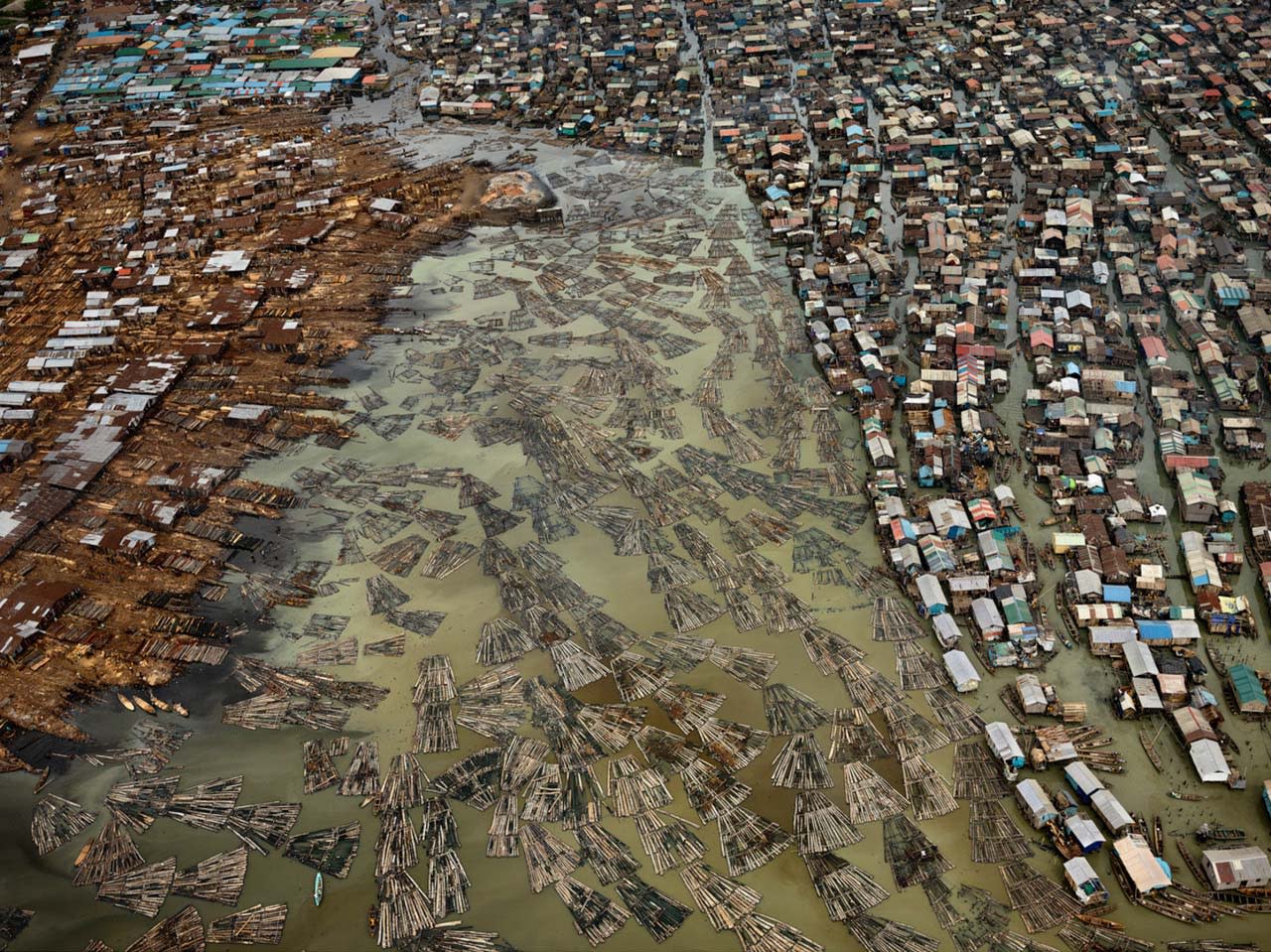
Edward Burtynsky, Saw Mills #2, Lagos, Nigeria, 2016. Pigment inkjet print on Kodak Professional Photo Paper © Edward Burtynsky, courtesy Metivier Gallery, Toronto.
Were you working digitally yet, at that time?
I made the jump to digital in 2005. I found that shooting digitally from a helicopter was better than shooting film. All of a sudden the aerial photography in digital was better. So with that, I started to acquire digital technology and gyro stabilizers for my camera. I started working in 2007 on my first full-on digital project, which was shooting mines in Australia. I was renting planes and helicopters to do that work. That was really my first series of aerial views that I did.
I really became fascinated with how that higher perspective of 500, 600, 700, 800 feet, revealed a lot to me, in a more compelling way. It spoke to me about how I could really show what’s happening.
It’s much easier to find a surreal moment in these places where the scale and the color and the combination, all of that, took you to a place that’s not of this world—though they are.
I kept adjusting my heights based on the subject matter. I did another project in Spain, and I tried to stay with that 700-800 feet rule, but they didn’t work, there was something wrong with them. So the next day I wanted to go up, and I just keep going up. I found it was around 1500-1800 feet where the subject matter really became interesting. So I said: so much for that rule! Let the subject matter tell you where to be. I started using that as my rule—allow my subject matter to guide me to determine where to stand. Ultimately I started to see the helicopter as an extended tripod.
Let’s say I was shooting with film and it was actually a better result on the wall on a big print, than the digital. Then I wouldn’t go with digital. My one rule is that if it does a better job then I move to the better job.
You don’t care if it’s newer or fancier, it’s whatever works best?
Yes. Correct. And also now we’re using photogrammetry—that’s taking multiple digital two-dimensional photographs of an object to create a three-dimensional photograph.
That’s for your Augmented Reality work at the AGO? Can you tell me a bit about those projects?
Yes. It’s our first really successful attempt to try and use AR. Again, I’m trying not to use it just because it’s a new shiny object to play with. It’s more, how do I take something 3D and engage with it in a way that makes sense, that creates and does something that photography can’t do? So it has importance and meaning to my work, and sits in the context of the larger issues I’m trying to grapple with in the work that I do.
For the Anthropocene Project, we [collaborators Jennifer Baichwal and Nicholas de Pencier] all decided we were going to do the burning of the tusk piles. [Burning the tusks was an initiative by the president of Kenya, Uhuru Kenyatta, in protest of the poaching of elephants within the country]. It was tusks from 8,000 elephants, about 16,000 tusks; there were 11 piles of these tusks. It took a week to build these pyramids of tusks. We spent the whole week with them as they were moving them from containers and putting them onto these pyres and then they burnt them.
The president had a pile of these big super tusks. These are tusks so big it takes two to carry them. You can imagine when a poacher goes into a herd of elephants they look around at who has the biggest tusks—that’s going to have the biggest yield in terms of the value. So they go for the big male elephants, kill them, and chainsaw the tusks off.
They say there’s less than 100 of them left in all of Africa, that’s how battered they’ve been by poachers. This pile of huge tusks are from a lot of the biggest elephants in Africa. We wanted to capture this pyre, so we got access to it for a couple of hours. Knowing how to use photogrammetry, we took 2,500 images of all different views and the nooks and crannies. So now [at the Art Gallery of Ontario] we’ve recreated that tusk pile in 3D so you can now experience it in the round, almost at scale. You can now walk around the pile. In a way it’s an image, but it’s more of a sculptural image.You can use your phone or an iPad to move around the pile; you can go closer and further back. It’s a way to bring that moment forward as a three-dimensional digital experience of that pile.
All of my landscapes aren’t disaster landscapes—these are business-as-usual landscapes. These are the things that we create.
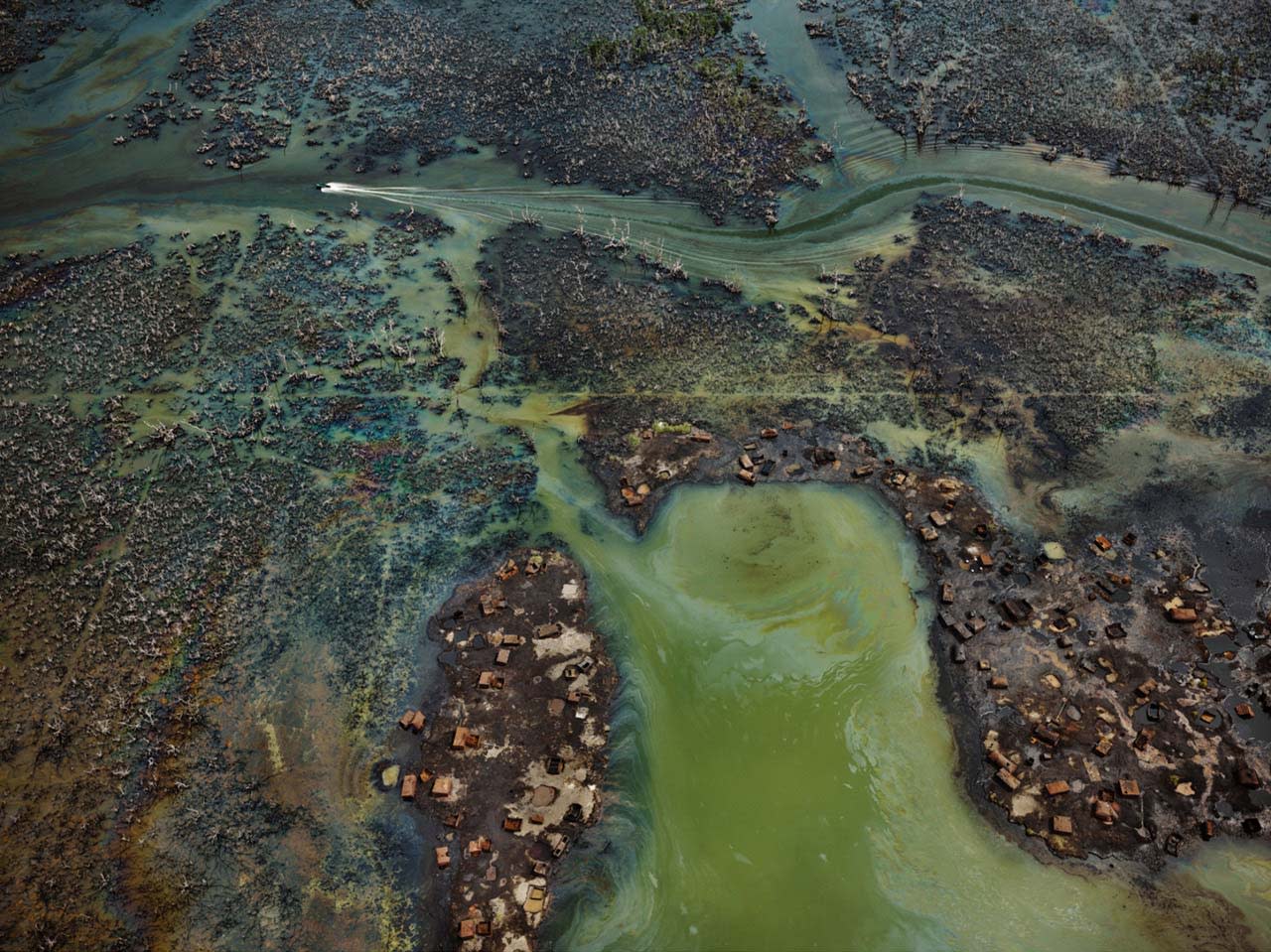
Edward Burtynsky, Oil Bunkering #4, Niger Delta, Nigeria, 2016. Pigment inkjet print on Kodak Professional Photo Paper © Edward Burtynsky, courtesy Metivier Gallery, Toronto.
That’s pretty devastating to think about, those tusks, and what they represent on this larger level of how poachers treat animals. I imagine that the AR piece is also really visually captivating, even if it is heart-wrenching. I wonder how you think about creating beautiful images of devastating things. Is beauty a device in your work—is it just that part of being a photographer is that you want to make an attractive image? Do you think about that negotiation?
Yeah, I do. A lot of people say they’re images of devastation. Well, arguably you could say that, but you could also say our cities are sitting on what used to be forests—they are devastated forests. Now we have all these materials we harvested from nature, so our cities are images of devastation as well. It’s a complex problem that we’re in.
All of my landscapes aren’t disaster landscapes—these are business-as-usual landscapes. These are the things that we create. There is design and engineering in a mine or a quarry. We have engineers that cut this way and not that way. Everything is a considered thing in these landscapes. They’re planned and engineered. But it’s really form following function in the truest sense.
No one’s trying to create an aesthetic in those mines or the refinery; they’re trying to get the result and spend as little money as possible for the greatest return. They are not going to waste any energy on something that isn’t necessary. Everything is the most economical and technologically expedient way to do that task, to get that material, because it impacts the profitability of that operation. So I understand that these are all very intentional and engineered landscapes and they’re, as far as I’m concerned, equivalent to our cities. We might not like what it looks like.
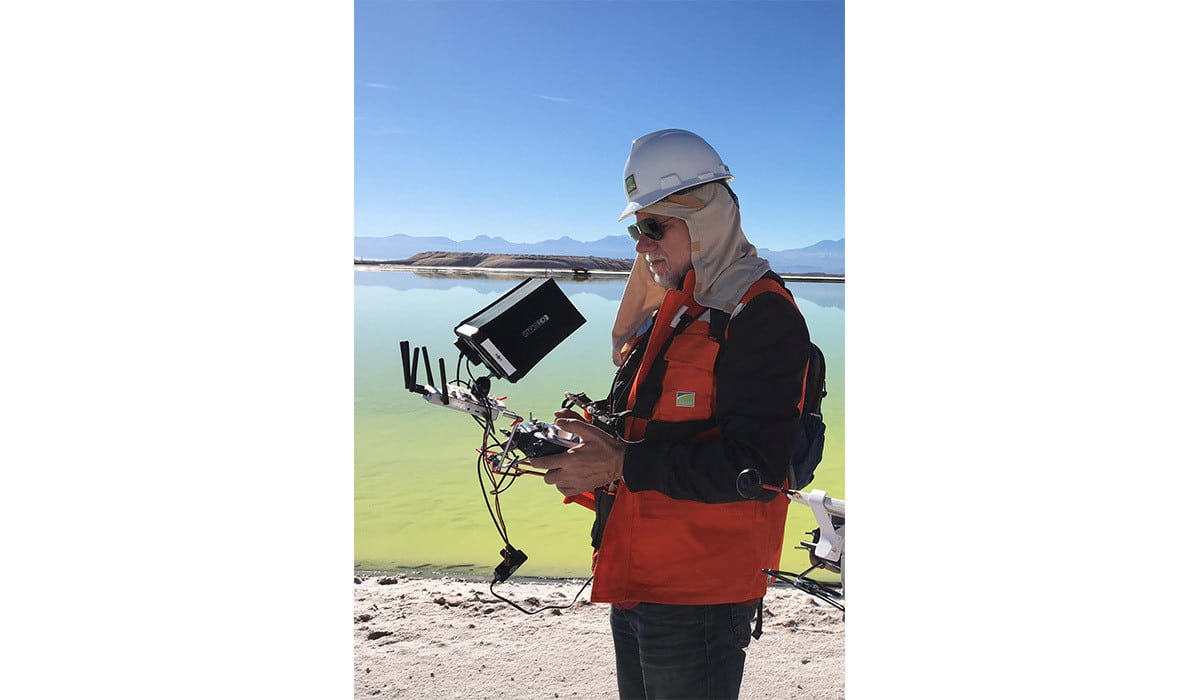
Burtynsky at work, Atacama Desert, Chile (2017). Photo courtesy Jim Panou.
I think the opposite actually—the photographs look very stunning, they’re so painterly and a lot look like textiles. I just wondered more about how you think about composing an image. Do you think that beauty functions as a way to get people thinking more deeply about these things?
There was a project I did with Brent McIntosh, maybe ten years ago, called Twice Removed. My picture was from nature and then Brent did a painting from those pictures I took. That was really early, from the late 70s and early 80s. Before I was documenting mines, I was looking at these landscapes, particularly when the leaves are down. I was interested in late fall or early spring just after the snows goes, the kind of complexity and texture you get, the kind of chaos you get in the forest and brush. I did a whole series trying to compress that space, maybe riffing a bit off of abstract expressionism and the flattening of space.
The whole notion of going into chaos—which is when you walk through a forest. It’s chaotic. Highly detailed, especially when the leaves are all down. There’s no green. It’s just looking at branches, leaves, and brush, all that stuff. To me it was attenuating my eye, to be able to walk into chaotic space, and somehow train it in such a way that all of a sudden it seems like it always made sense as a picture. It is an interesting picture because all that busyness becomes taut. It creates an image that’s compelling to look at.
It was like I learned my scales out there in the forest. Now I walk into a mine company and I start wandering around, looking and wondering at this chaos, and a place that’s by and large pretty ugly and boring. Most people would walk into a mine and just walk right out again and say “Jesus, that’s pretty grim, visually.” I walk in there and say, I’m not going to give up. I’m just going to keep trying to understand how to photograph it in a way that when people go look at it, they don’t avert their eyes. I was using some of this same technique I developed when shooting that landscape, and applying that same attenuation to a place.
Most people would walk into a mine and just walk right out again and say “Jesus, that’s pretty grim, visually.” I walk in there and say, I’m not going to give up.
As an example, I decided at one point I’m going to go photograph refineries, because that’s where plastics come from; oil, gas, kerosene, butane, and jet fuel, all of that comes from this place. I went in there and first shot with a two and a quarter camera, just wandering around and seeing what’s possible in there. I took some rolls of 1-20 film, a kind of sketching. I came back and found about four or five images on the film that I found sort of interesting. I printed them, blew them up. Then went back and shot with a whole bunch of different materials. I shot with Ektachrome, Fujifilm, and Polaroid film, came back, and processed the film to see how it’s going to react. I started printing on different papers. I then combine those two things together and now I have my materials down to what I want, and to the palette that I find works within that space.
While I’m continuing to shoot I’m also working out what I shoot. I take more images, maybe two images are interesting and the rest not so much. I start to think about why they’re interesting. I think on the fourth or fifth trip I had finally gotten to the point where I felt, I have now found a way to capture this in a compelling way. I’ve worked through that chaos and complexity and found where I believe the images reside—where they became interesting.
In a lot of cases that’s the process I would go through. I keep going at it until I’ve distilled it down to the visual moment that I feel would make someone look at a refinery. They, in many ways, almost felt cathedral-esque, industrial palaces almost—of pipes and steam, and big pressure boilers, all of that aluminum and shiny. The guys that worked there, they’d drive bikes around and stop and say “What the hell are you doing here? Why are you at all interested in photographing this?”
It goes back to one of the things I fell in love with in some of the early modernists, like Edward Weston, he would take [something] everyday or banal like a pepper or a cabbage and cut in half. Then all of a sudden it looks like a stunning and sensuous nude, almost. Seeing the extraordinary in the ordinary by the act of perception, in many ways I share that intrigue; the things that people walk by and never think twice, I would go and then try to find the extraordinary in that.
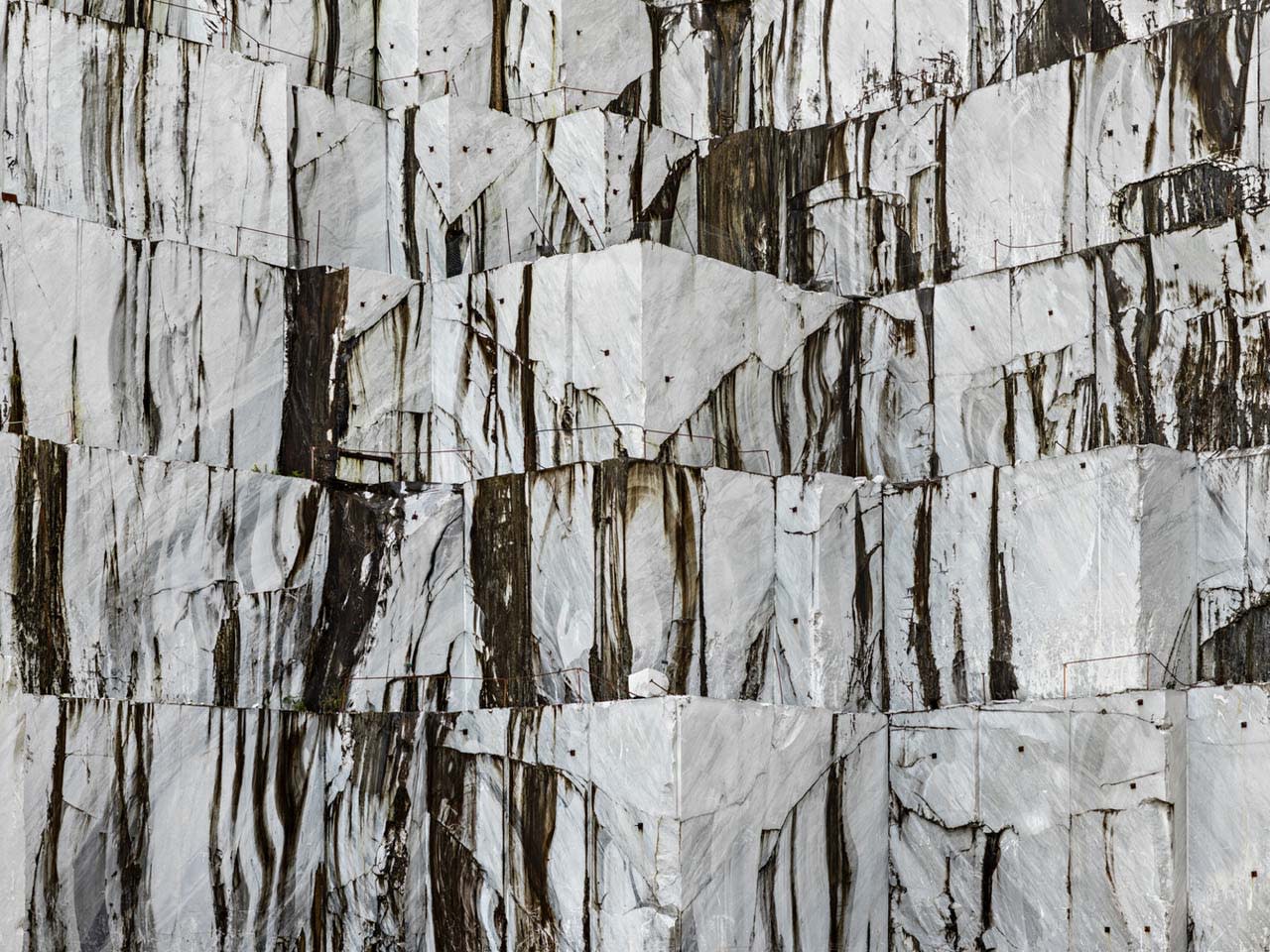
Edward Burtynsky, Carrara Marble Quarries, Cava di Canalgrande #1, Carrara, Italy, 2016. Pigment inkjet print on Kodak Professional Photo Paper © Edward Burtynsky, courtesy Metivier Gallery, Toronto.
I have one last question. In these new works you have revisited the Carrara Marble Quarries and taken new images. I’m interested in how you’re tracking the progress at the quarries. What made you want to revisit it? Are you interested in thinking about the temporality of the photograph, and its relationship to time in those images?
It was interesting because these were some of the biggest quarries in the world, and I was coming back 25 years later after first photographing them. We were looking for large scale extractive industries in our discussions, because we’re working as a collaborative.
I thought Carrara represented a big step in my career, on that up until 1992 I had only shot in North America. In 1992, I had heard that there’s these incredible quarries in Carrara in Northern Italy. I didn’t speak the language or know how to navigate something like that. But I bumped into an Italian photographer at Toronto Image Works in Toronto. He said he knew a guy in that area who was a photo assistant. I called Sylvio, he spoke good English, so I made a deal with him, and he was my guide. He went out ahead of time and negotiated so I could shoot.
All of sudden, I was shooting in a country I didn’t speak the language, I’m no longer shooting in North America, and I moved all my gear over there. It was the beginning of looking at the planet as a whole, not just North America. I thought, wouldn’t it be interesting to go back to Carrara exactly 25 years later?
But now I’m going back with drones, not even with any film, it’s all digital, with the ability to stitch images together and all this technology I’ve mastered. I went in there with a whole set of tools I could never even dream of, [including] a 100 megapixel Hasselblad on a drone [so that I could ] shoot in any perspective I wanted. So I could shoot the quarries in a way that I could only dream of. The 100 pixel Hasselblad is certainly better than a 4×5 , maybe not an 8×10 but somewhere in between. I have the ability to put my camera almost anywhere and shoot. To me it was a really exciting moment to go back to a site, with another 25 years of experience and tools.
Wow. It was revisiting this formative moment for you. That’s so wonderful. It must been really nice to reflect on how you first started being out in the world photographing internationally and returning with all of your experience. This whole exhibition seems in cumulative of your work also.
The word [Anthropocene] and the idea seem to be an amazing umbrella, a canopy under which a lot of the work I’ve done seems to all fit. I’ve been pretty much focused on large scale human interventions in the landscape. Going back to walking in nature, and that sense of geological time, I acquired that in my early days as an avid canoer and camper. Paddling along these grand shores of lakes in northern Ontario, this is exactly what a First Nations person would have seen 10,000, 15,000 years ago, whenever they got there. And maybe a beaver who was swimming by would have see it 100,000 years ago.
That deep reference point to what nature intended in that landscape, that to me speaks to deep geological time—this is how it looked for many. many millennia. To then go and look at how we’re reshaping nature, to have an empathy for the loss of it, that is the motivation. It’s a kind of lament for the loss of nature with this human imprint that’s now extending around the world. The whole work I see as a quiet lament: a look at our success, and at the cost of all other life forms on the planet.
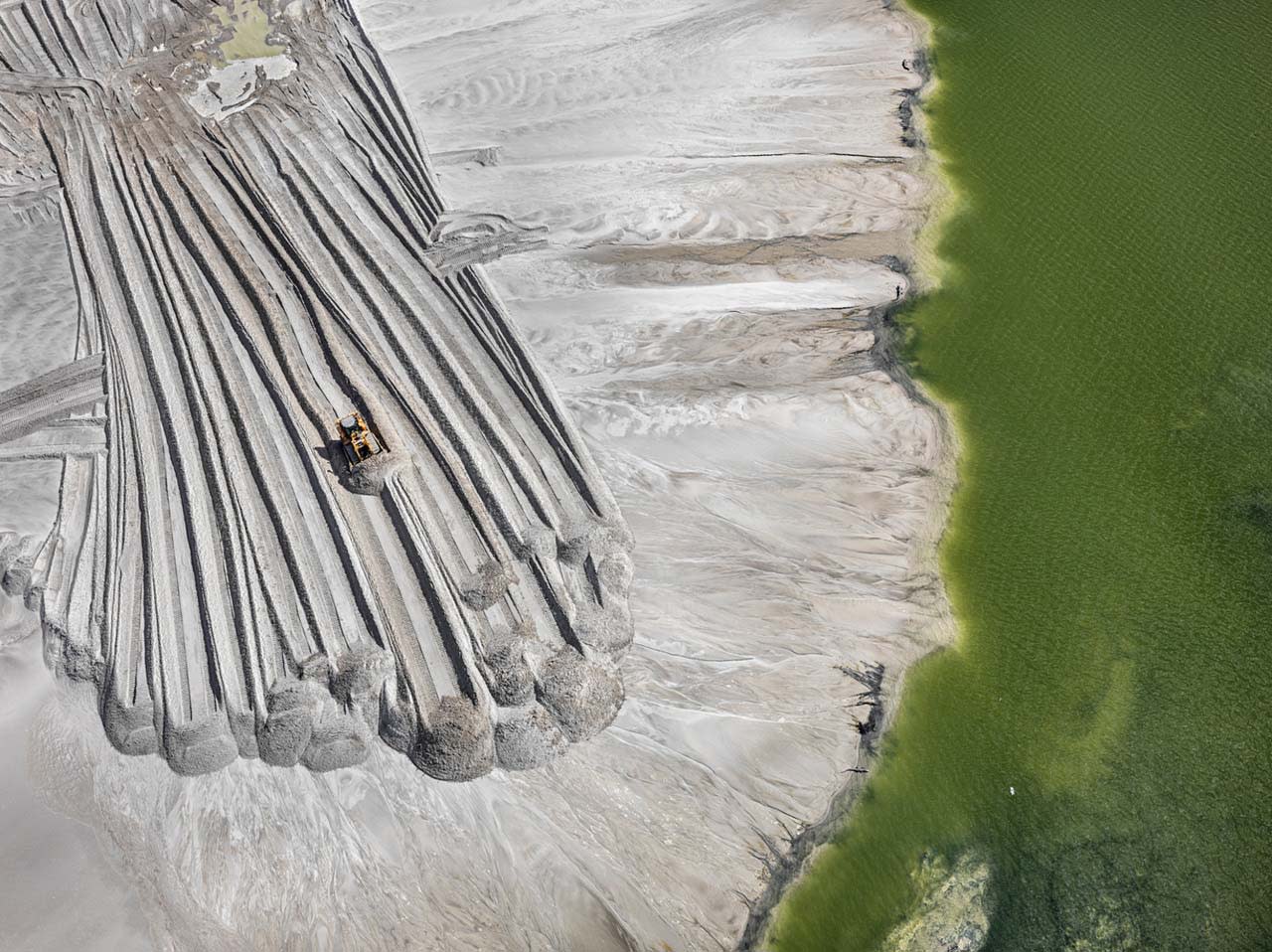
Edward Burtynsky, Phosphor Tailings Pond #4, Near Lakeland, Florida, USA, 2012. Pigment inkjet print on Kodak Professional Photo Paper © Edward Burtynsky, courtesy Metivier Gallery, Toronto.
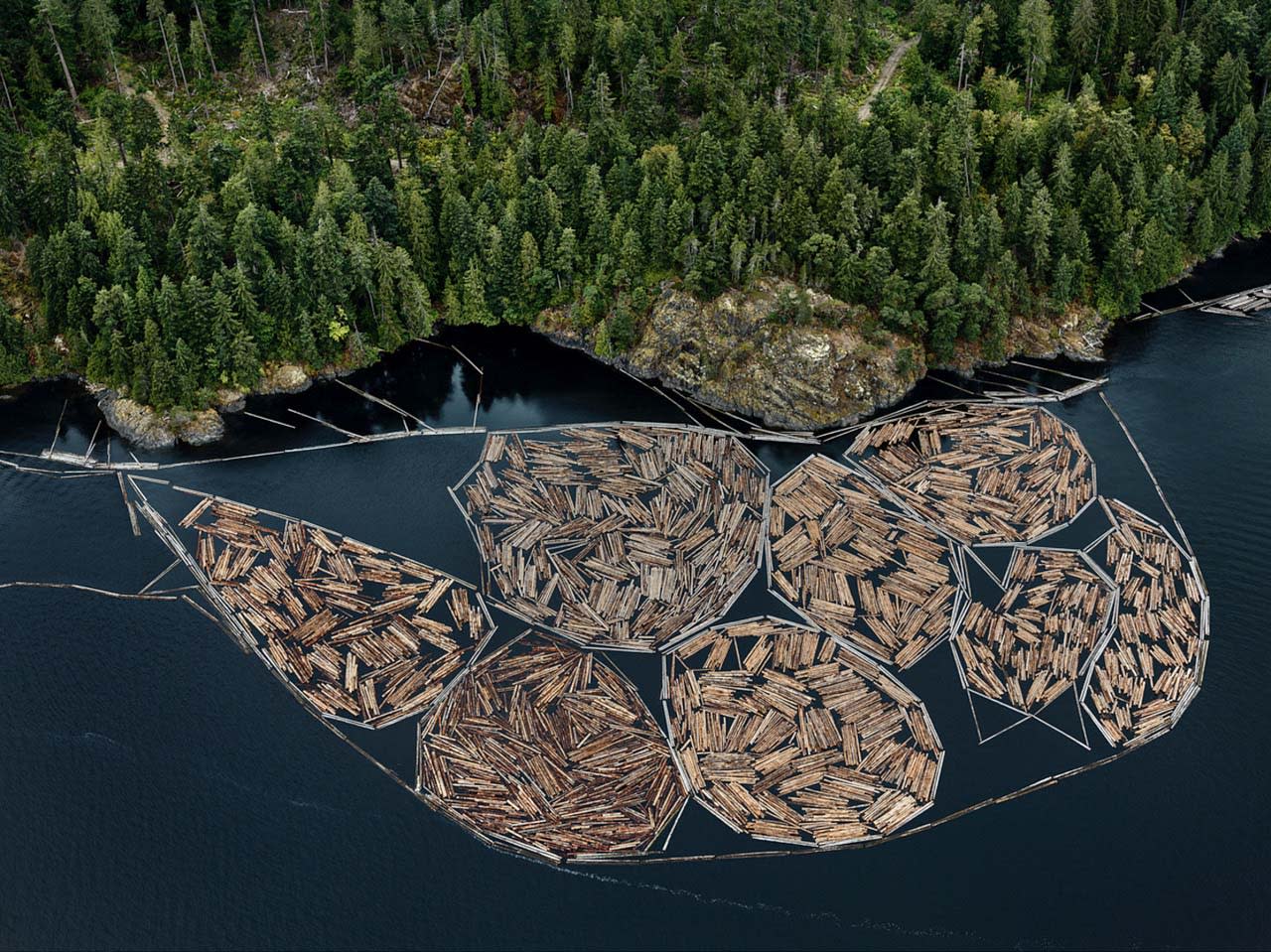
Edward Burtynsky, Log Booms #1, Vancouver Island, British Columbia, Canada, 2016. Pigment inkjet print on Kodak Professional Photo Paper © Edward Burtynsky, courtesy Metivier Gallery, Toronto.
Cover image: Edward Burtynsky, Uralkali Potash Mine #4, Berezniki, Russia, 2017 (detail). Pigment inkjet print on Kodak Professional Photo Paper © Edward Burtynsky, courtesy Metivier Gallery, Toronto.
